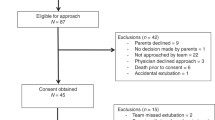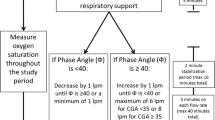Abstract
Objective:
To compare the work of breathing (WOB) in premature neonates supported with high-flow nasal cannula (HFNC) and nasal continuous positive airway pressure (NCPAP).
Study Design:
Eighteen preterm neonates <2.0 kg on HFNC or NCPAP support were studied in a random order. A ventilator was used to deliver 6 cm H2O of NCPAP with nasal prongs. High-flow nasal cannula delivered with Vapotherm (VAPO) at 3, 4 and 5 l/min was used. Tidal ventilation was obtained using respiratory inductance plethysmography calibrated with face-mask pneumotachography. An esophageal balloon estimated pleural pressure from which changes in end distending pressure were calculated. Inspiratory, elastic and resistive WOB and respiratory parameters were calculated.
Results:
No differences were found in the WOB for all settings. Changes in end distending pressure did not vary significantly over all device settings except VAPO at 5 l/min.
Conclusion:
In these preterm infants with mild respiratory illness, HFNC provided support comparable to NCPAP.
This is a preview of subscription content, access via your institution
Access options
Subscribe to this journal
Receive 12 print issues and online access
$259.00 per year
only $21.58 per issue
Buy this article
- Purchase on Springer Link
- Instant access to full article PDF
Prices may be subject to local taxes which are calculated during checkout



Similar content being viewed by others
References
DePaoli AG, Davis PG, Faber B, Morley CJ . Devices and pressure sources for administration of nasal continuous positive airway pressure (NCPAP) in preterm neonates. Cochrane Database Syst Rev 2002; (4): CD0022977.
Gitterman MK, Fush C, Gitterman AR, Regazzoni BM, Moessinger AC . Early nasal continuous positive airway pressure treatment reduces the need for intubation in very low birth weight infants. Eur J Pediatr 1997; 156 (5): 384–388.
Davis P, Henderson-Smart D . Post-extubation prophylactic nasal continuous positive airway pressure in preterm infants: systematic review and meta-analysis. J Paediatr Child Health 1999; 35 (4): 367–371.
O'Brien KE Vapotherm. Available from: http://www.chw.org/display/PPF/DocID/30881/router.aspAccessed December 14, 2005.
Ramanathan A, Cayabyab R, Sardesai S, Siassi B, Seri I, Ramanathan R . High flow nasal cannula use in preterm and term newborns admitted to neonatal intensive care unit: a prospective, observational study. E-PAS 2005; 57: 3424.
Sun S, Tero R . Safety and efficacy of the Vapotherm 2000i in the neonatal population. Respir Care 2004; 49 (11): 1384.
Juretschke R, Spoula R . High flow nasal cannula in the neonatal population. Neonat Intens Care 2004; 17 (6): 20–21.
Courtney SE, Pyon KE, Saslow JG, Arnold GK, Pandit PB, Habib RH . Lung recruitment and breathing pattern during variable versus continuous flow nasal continuous positive airway pressure in premature infants: an evaluation of three devices. Pediatrics 2001; 107: 304–308.
Pandit PB, Courtney SE, Pyon KE, Saslow JG, Habib RH . Work of breathing during constant- and variable-flow nasal continuous positive airway pressure in preterm neonates. Pediatrics 2001; 108 (3): 682–685.
Pandit PB, Pyon KH, Courtney SE, England SE, Habib RH . Lung resistance and elastance in spontaneously breathing preterm infants: effects of breathing pattern and demographics. J Appl Physiol 2000; 88: 997–1005.
Courtney SE, Aghai ZH, Saslow JG, Pyon KH, Habib RH . Changes in lung volume and work of breathing: a comparison of two variables-flow nasal continuous positive airway pressure devices in very low birth weight infants. Pediatr Pulmonol 2003; 36: 248–252.
Campbell EJM . The Respiratory Muscles and the Mechanics of Breathing. Year Book Publishers: Chicago, IL, 1958, pp 1–117.
Richardson CP, Jung AL . Effects of continuous positive airway pressure on pulmonary function and blood gases of infants with respiratory distress syndrome. Pediatr Res 1978; 12: 771–774.
Polin RA, Rakesh S . Newer experience with CPAP. Semin Neonatol 2002; 7: 379–389.
Vapotherm. Available from: http://www.nichemedical.com.au/web/vapotherm.htmlAccessed December 14, 2005.
Lain DC, Lain C, Waugh JB . Average temperature and flow using Vapotherm in an adult population. Chest Suppl 2004; 126 (4): 899S.
Nair G, Karna P . Comparison of the effects of Vapotherm and nasal CPAP in respiratory distress in preterm infants. E-PAS 2005; 57: 2054.
Chang GY, Cox CA, Shaffer TH . Nasal cannula, CPAP, and Vapotherm: effect of flow on temperature, humidity, pressure and resistance. E-PAS 2005; 57: 1231.
Locke RG, Wolfson MR, Shaffer TH, Rubenstein D, Greenspan JS . Inadvertent administration of positive end-expiratory pressure during nasal cannula flow. Pediatrics 1993; 91: 135–138.
Sreenan C, Lemke RP, Hudson-Mason A, Osiovich H . High-flow nasal cannulae in the management of apnea of prematurity: a comparison with conventional nasal continuous positive airway pressure. Pediatrics 2001; 107 (5): 1081–1083.
Acknowledgements
This study was conducted at Cooper University Hospital. Equipment support was provided by Vapotherm Inc., Stevensville, Maryland. None of the authors received any goods or money from Vapotherm, or hold any stock in this company. This work was presented in part at the Society for Pediatric Research/Pediatric Academic Societies Meeting in Washington, DC, May 2005.
Author information
Authors and Affiliations
Corresponding author
Rights and permissions
About this article
Cite this article
Saslow, J., Aghai, Z., Nakhla, T. et al. Work of breathing using high-flow nasal cannula in preterm infants. J Perinatol 26, 476–480 (2006). https://doi.org/10.1038/sj.jp.7211530
Received:
Revised:
Accepted:
Published:
Issue Date:
DOI: https://doi.org/10.1038/sj.jp.7211530
Keywords
This article is cited by
-
High-Flow Nasal Oxygenation and Its Applicability in COVID Patients
SN Comprehensive Clinical Medicine (2022)
-
Adjustment of high flow nasal cannula rates using real-time work of breathing indices in premature infants with respiratory insufficiency
Journal of Perinatology (2021)
-
Cardiorespiratory behavior of preterm infants receiving continuous positive airway pressure and high flow nasal cannula post extubation: randomized crossover study
Pediatric Research (2020)
-
Diaphragm electromyography results at different high flow nasal cannula flow rates
European Journal of Pediatrics (2019)
-
Nasal high flow treatment in preterm infants
Maternal Health, Neonatology and Perinatology (2017)



